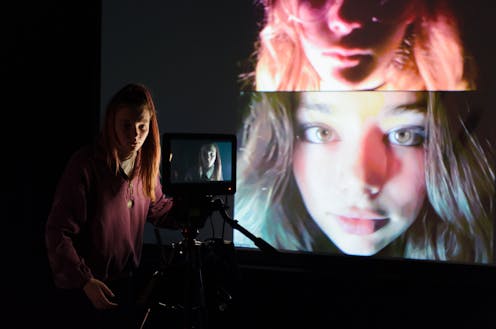Anything & Everything gives us a glance into the lives teenagers are constructing online
- Written by Thuy Tran, PhD Candidate, The University of Melbourne

Review: Anything & Everything, Platform Arts, infinity ensemble for Rising.
Anything & Everything reminds me of a rite of passage we have all sailed through, in one way or another. That question we all ask: who am I?
The passage is quite different for the new generation. Anything & Everything, directed by Jackson Castiglione, is about the young people who navigate this question with social media embedded in their compass.
We are in a TV studio. Six amazing teenagers converse about how they look, who they are and what is expected of them while collaborating to film short videos of each other, constructing how they want to be seen by the world.
We see them throughout the hour simultaneously on stage and on a variety of screens. A production within a production. A play about identity construction, in which people learn to navigate the different layers of themselves.
You could ask how “real” these layers are.
Are the images on screen less real than what we see in real life (IRL)?
Does this reflection mean anything at all?
Or has it come to mean everything?
Read more: Teenagers need our support, not criticism, as they navigate life online[1]
What if you could see all angles of yourself?
A metaphor repeatedly invoked throughout the show is the idea of having butterfly eyes[2] – compound eyes of up to 17,000 lenses which, our cast says, could let them see everything all at once.
The performers ask each other what they would see if they could see themselves from all angles. One thinks about what it would mean to see herself from the back, rather than the front. Another speaks about how she could spy on everyone, knowing what they love and hate about themselves.
There is also an analogy between butterfly eyes and the digital technology we have today. One the one hand, technology gives us unprecedented power to see ourselves and others from many different perspectives, all at the same time. On the other, this power can be too much to handle – as one performer describes, it can be intimidating.
At the heart of Anything & Everything is the question of how young people find themselves in multiple realities, rather than a single overarching personality.
None of our teen protagonists say they would like to label themselves with a coherent and unified identity[3]. As Richard Jenkins, a professor of sociology, writes in his book about social identity[4], identity is not a thing, but a process.
It is fascinating to listen to these young people’s stories about how they navigate this process.
For older audiences, it might be a little surreal to realise how much social media channels such as TikTok and Instagram are now an essential part of these journeys.
Read more: Snapchat has its risks but it's a powerful tool for youth creativity and socialisation[5]
What is real?
Images on screen have often been perceived as a less authentic version of reality, with the potential for deception[6].
As screens become more ubiquitous, this perception is changing[7].
Throughout the show, the performers repeatedly discuss how they look and what they see, especially under the influence of digital technology. It is all about seeing. Visual culture[8] has come to dominate our lives. The screens are all around us.
For these teenagers, the online/offline binary or hierarchy seems to no longer matter. They think of their images on screen as real as their physical bodies.
The screens are not lying to them.
The kids learn to negotiate when certain elements among these multiple realities appear contradictory.
Am I different?
There are touching moments when the performers discuss how gender, racism and living with disabilities influence their sense of identity. Kids are not often expected to have a voice on these issues, and it might surprise some in the audience how much these young people can take in and reflect on.
Each story in the show speaks to the struggles we adults have been dealing with – often without talking to kids. We tend to think children should be protected from such problems.
It turns out they have their own stories: moving stories about fear, frustration, hope and courage. As the beautiful background music of the show says, “you don’t need to be afraid.” The kids are trying to be strong too, even without adults’ recognition.
Anything & Everything ends with an inspiring reflection from one of the ensemble members about identity as performance[9]. Interestingly, they say the idea came to them from an infographic on Instagram.
Identifying as non-binary, they reveal how realising that everyone’s gender identity is a performance gave them the courage to choose their gender – rather than fit into a box.
But the show is about more than individual agency. It asks if social discourses can be changed, such as the way we raise our girls with certain unconscious assumptions and expectations.
In that sense, Anything & Everything leaves us rethinking about young people’s identities, as well as the technological and social forces that influence the process of discovering who we are.
Anything & Everything is at ACMI until June 12.
References
- ^ Teenagers need our support, not criticism, as they navigate life online (theconversation.com)
- ^ butterfly eyes (buffalobayou.org)
- ^ a coherent and unified identity (psycnet.apa.org)
- ^ social identity (www.routledge.com)
- ^ Snapchat has its risks but it's a powerful tool for youth creativity and socialisation (theconversation.com)
- ^ potential for deception (www.washingtonpost.com)
- ^ changing (www.wellbeing.com.au)
- ^ Visual culture (www.routledge.com)
- ^ identity as performance (2ser.com)

















